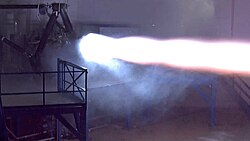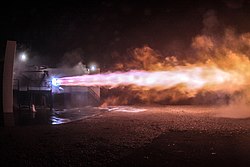Raptor (rocket engine)

First test firing of a Raptor development engine on September 25, 2016 in McGregor, Texas.
|
|
| Country of origin | United States |
|---|---|
| Manufacturer | SpaceX |
| Application | Multistage propulsion |
| Status | In development |
| Liquid-fuel engine | |
| Propellant | LOX / liquid methane |
| Mixture ratio | 3.8 |
| Cycle | Full-flow staged combustion |
| Pumps | 2 × multi-stage |
| Configuration | |
| Chamber | 1 |
| Nozzle ratio | 150 atmospheric, 200 vacuum |
| Performance | |
| Thrust (vac.) | ~3,285 kN (738,000 lbf) |
| Thrust (SL) | 3,050 kN (690,000 lbf) |
| Chamber pressure | 30 MPa (4,400 psi) |
| Isp (vac.) | 361 s |
| Isp (SL) | 334 s |
| Dimensions | |
| Diameter |
Atmospheric <2 m (6 ft 7 in) Vacuum- 4 meters |
| Used in | |
| ITS launch vehicle booster stage, Interplanetary Spaceship, ITS tanker | |

First test firing of the one-third scale Raptor development engine on September 25, 2016 in McGregor, Texas.
|
|
| Country of origin | United States |
|---|---|
| Manufacturer | SpaceX |
| Application | Multistage and deep-space propulsion |
| Status | Development |
| Liquid-fuel engine | |
| Propellant | LOX / liquid methane |
| Mixture ratio | 3.8 |
| Cycle | Full-flow staged combustion |
| Pumps | 2 × multi-stage |
| Configuration | |
| Chamber | 1 |
| Nozzle ratio | 200 |
| Performance | |
| Thrust | 3,500 kN (790,000 lbf) |
| Chamber pressure | 30 MPa (4,400 psi) |
| Specific impulse | 382 s |
| Dimensions | |
| Diameter | ~4 m (13 ft) |
| Used in | |
| Interplanetary Spaceship, ITS tanker | |
Atmospheric <2 m (6 ft 7 in)
Raptor is a family of cryogenic, methane-fueled rocket engines under development by SpaceX. The engines are specifically intended to power both high-performance lower and upper stages of the ITS launch vehicle, a part of a more extensive Interplanetary Transport System (ITS) championed by Elon Musk, that may provide technological and economic improvements in interplanetary spaceflight, particularly with respect to a long-term aim of colonizing Mars. The engine will be powered by densified liquid methane and liquid oxygen (LOX), rather than the RP-1 kerosene and LOX used in all previous Falcon 9 rockets which use Merlin 1C & D engines. The earliest concepts for Raptor considered liquid hydrogen (LH2) as fuel rather than methane. The Raptor engine will have over three times the thrust of the Merlin 1D vacuum engine that powers the current Falcon 9 launch vehicle.
The broad Raptor concept "is a highly reusable methane staged-combustion engine that will power the next generation of SpaceX launch vehicles designed for the exploration and colonization of Mars". According to Elon Musk, this design will be able to achieve full reusability of all rocket stages and, as a result, "a two order of magnitude reduction in the cost of spaceflight". A variety of Raptor engines will be used on both stages of the ITS launch vehicle, but also on the long-duration spacecraft used to support all aspects of the Interplanetary Transport System on-orbit. Both the ITS tanker—a transport carrier of propellant cargo to Earth orbit—and also the Interplanetary Spaceship—a very long-duration carrier of both passengers and space cargo to interplanetary destinations, and which will also serve as both a descent and ascent vehicle at Mars—will be powered by six vacuum-optimized Raptor rocket engines with three additional sea-level-nozzle Raptor engines to be used for maneuvering. The ITS booster stage will be powered by 42 Raptors. Unlike nearly all other launch vehicles or spacecraft, on all Earth-away launches, the long-duration spacecraft (tanker or spaceship) will also provide second-stage acceleration to orbital velocity; all propulsion is provided by Raptor engines.
...
Wikipedia
